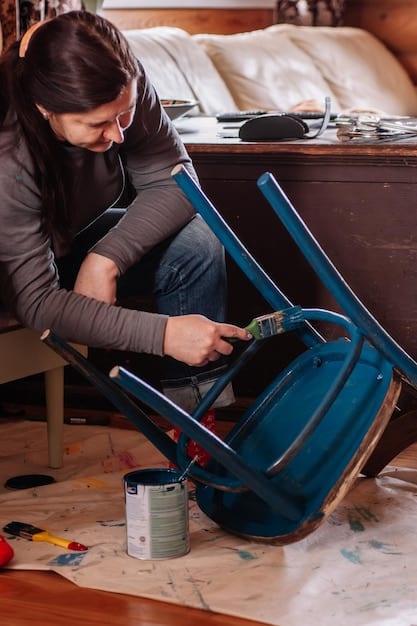Sustainable Living on a Budget: Save $500+ This Year

Sustainable living on a budget involves practical strategies like reducing food waste, conserving energy, DIY repairs, and mindful shopping to save over $500 annually while minimizing environmental impact.
Embarking on a journey towards sustainable living on a budget doesn’t have to break the bank; in fact, it can lead to significant savings. It’s about making conscious choices that benefit both your wallet and the environment.
Understanding Sustainable Living and Its Financial Benefits
Sustainable living is often perceived as an expensive endeavor, but this couldn’t be further from the truth. Embracing eco-friendly habits can unlock substantial savings while contributing to a healthier planet. It’s a win-win situation that benefits both your pocket and the environment.
What is Sustainable Living?
Sustainable living encompasses lifestyle choices that aim to reduce our environmental impact. This includes conserving resources, minimizing waste, and making responsible consumption decisions. By integrating these practices into our daily routines, we can create a more sustainable future.
How Does It Save You Money?
Many sustainable practices directly translate to lower expenses. For instance, reducing energy consumption through efficient appliances and mindful usage decreases utility bills. Similarly, cutting down on food waste and embracing simple DIY repairs can prevent unnecessary spending.

Simple Steps to Reduce Food Waste and Save
Food waste is a significant problem both environmentally and economically. By mindfully managing your food consumption, you can eliminate waste and save hundreds of dollars each year. This involves planning your meals, storing food properly, and creatively using leftovers.
- Plan Your Meals: Before heading to the grocery store, create a meal plan for the week. This helps you buy only what you need, reducing the likelihood of food spoiling before you can use it.
- Proper Food Storage: Understanding how to store different types of food can significantly extend their shelf life. Use airtight containers, refrigerate promptly, and learn which foods thrive in different environments.
- Embrace Leftovers: Get creative with leftovers. Transform them into new dishes or freeze them for future meals. This reduces waste and saves time on meal preparation.
- Composting: Compost food scraps instead of throwing them away. Compost can be used to enrich garden soil, reducing the need for store-bought fertilizers.
By implementing these strategies, you can drastically reduce food waste and keep more money in your pocket. It’s a simple but effective way to contribute to a more sustainable and economical lifestyle.
Conserving Energy at Home: Easy and Affordable Methods
Energy consumption is a major expense for most households. By adopting energy-efficient habits, you can significantly lower your utility bills without sacrificing comfort. Small changes in your daily routine can make a big difference in your energy usage and savings.
- Switch to LED Lighting: Replace traditional light bulbs with energy-efficient LEDs. They use significantly less electricity and last much longer, saving both energy and replacement costs.
- Unplug Electronics: Many electronics continue to draw power even when turned off. Unplug chargers, appliances, and other devices when not in use to eliminate “phantom” energy consumption.
- Adjust Your Thermostat: During cooler months, lower your thermostat a few degrees. In warmer months, raise it slightly. Using a programmable thermostat can automate these adjustments.
- Efficient Appliance Use: Use appliances like washing machines and dishwashers only when they are fully loaded. Clean the lint trap in your dryer after each use to improve efficiency.
These simple steps can lead to substantial energy savings over time. By integrating these habits into your daily routine, you’ll not only save money but also reduce your environmental footprint.
DIY Repairs and Upcycling: Saving Money and Resources
Instead of immediately replacing broken items, consider DIY repairs and upcycling. These practices can save you money, reduce waste, and even provide a creative outlet. With a little effort and ingenuity, you can extend the life of your belongings.
Basic DIY Repair Skills
Learning basic repair skills is a valuable investment. Start with minor fixes around the house, such as patching holes in walls, fixing leaky faucets, or repairing broken furniture. Many online tutorials and courses can guide you through the process.

The Art of Upcycling
Upcycling involves transforming discarded items into something new and useful. Old clothes can be turned into cleaning rags, glass jars can become storage containers, and wooden pallets can be repurposed into furniture. The possibilities are endless.
By embracing DIY repairs and upcycling, you can save money on replacements and reduce the amount of waste sent to landfills. These practices are not only cost-effective but also environmentally responsible.
Mindful Shopping: Making Conscious Consumption Choices
Mindful shopping involves being aware of your consumption habits and making deliberate purchasing decisions. This means buying only what you need, choosing quality over quantity, and supporting sustainable businesses. By being a conscious consumer, you can save money and promote ethical practices.
- Buy Only What You Need: Avoid impulse purchases and stick to your shopping list. Before buying something, ask yourself if you truly need it and whether you will use it frequently.
- Choose Quality Over Quantity: Invest in durable, well-made products that will last longer. While they may cost more upfront, they will save you money in the long run by reducing the need for frequent replacements.
- Support Sustainable Businesses: Look for companies that prioritize sustainability and ethical practices. These businesses often use eco-friendly materials, reduce waste, and treat their workers fairly.
- Consider Secondhand Options: Explore thrift stores, consignment shops, and online marketplaces for used items. You can often find high-quality goods at a fraction of the original price.
Mindful shopping not only saves you money but also encourages responsible consumption. By making conscious choices, you can support a more sustainable and equitable economy.
Transportation Savings: Eco-Friendly Commuting Options
Transportation costs can be a significant expense, especially for daily commuters. Exploring eco-friendly commuting options like biking, walking, and public transportation can save you money and reduce your carbon footprint. These alternatives offer health benefits and contribute to a cleaner environment.
Biking and Walking
If your commute is short enough, consider biking or walking. These options are not only free but also provide excellent exercise. Invest in a comfortable bike and appropriate safety gear to make your commute enjoyable and safe.
Public Transportation
Public transportation is a cost-effective and environmentally friendly way to get around. Explore bus, train, and subway options in your area. Many cities offer monthly passes or discounted fares for regular commuters.
Carpooling
Carpooling with coworkers or neighbors can reduce transportation costs and emissions. Share driving responsibilities and split the cost of gas and parking. This option provides social interaction and contributes to a more sustainable commute.
By adopting eco-friendly commuting options, you can save money on transportation expenses and reduce your environmental impact. These choices promote a healthier lifestyle and contribute to a more sustainable community.
Water Conservation: Simple Ways to Reduce Usage and Save
Conserving water is essential for both the environment and your water bill. By adopting water-saving habits, you can significantly reduce your usage and lower your expenses. Small adjustments in your daily routine can make a big difference in your water consumption.
- Fix Leaks Promptly: Even small leaks can waste a significant amount of water over time. Repair leaky faucets, toilets, and pipes as soon as you notice them.
- Install Water-Efficient Fixtures: Consider replacing old toilets, showerheads, and faucets with water-efficient models. These fixtures use less water without sacrificing performance.
- Shorten Shower Times: Reducing your shower time by just a few minutes can save a considerable amount of water. Set a timer or challenge yourself to take shorter showers.
- Water Your Lawn Efficiently: Water your lawn early in the morning or late in the evening to minimize evaporation. Use a sprinkler system that delivers water directly to the roots.
By implementing these water conservation strategies, you can reduce your water bill and contribute to a more sustainable future. Protecting our water resources is crucial for the health of our planet.
| Key Point | Brief Description |
|---|---|
| 💡 Reduce Food Waste | Plan meals, store food correctly, and use leftovers creatively to avoid waste. |
| ⚡ Conserve Energy | Switch to LED lights and unplug electronics to lower energy consumption. |
| 🛠️ DIY Repairs & Upcycling | Fix broken items and transform old ones into new, useful products. |
| 🚶 Eco-Friendly Transport | Bike, walk, use public transport, or carpool for cheaper, greener commutes. |
FAQ
▼
Start by assessing your current spending habits and identifying areas where you can reduce waste. Prioritize reducing food waste and conserving energy as these are two of the most impactful and cost-effective changes you can make.
▼
Plan your meals, buy in bulk, and cook at home more often. Also, consider growing some of your own produce, even if it’s just herbs or a few vegetables in pots on your balcony. This reduces your reliance on store-bought items.
▼
Switch to LED lighting, unplug electronics when not in use, and adjust your thermostat. Insulating your home to prevent drafts can also significantly reduce your energy consumption and lower your utility bills.
▼
Fix leaks promptly, install water-efficient fixtures, and shorten your shower times. Additionally, be mindful of how you water your lawn and consider using rainwater harvesting systems to conserve water for outdoor use.
▼
Upcycling saves you money by repurposing items you already have, reduces waste sent to landfills, and allows you to express your creativity. It’s a fantastic way to create unique items while minimizing your environmental impact.
Conclusion
Adopting sustainable living on a budget is not only feasible but also beneficial for your finances and the planet. By implementing these practical strategies, you can save over $500 this year while reducing your environmental footprint and contributing to a more sustainable future. Start with small changes, and watch the savings grow!





